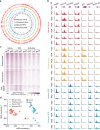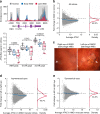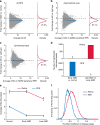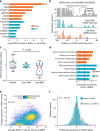ATAC-Seq analysis reveals a widespread decrease of chromatin accessibility in age-related macular degeneration
- PMID: 29636475
- PMCID: PMC5893535
- DOI: 10.1038/s41467-018-03856-y
ATAC-Seq analysis reveals a widespread decrease of chromatin accessibility in age-related macular degeneration
Abstract
Age-related macular degeneration (AMD) is a significant cause of vision loss in the elderly. The extent to which epigenetic changes regulate AMD progression is unclear. Here we globally profile chromatin accessibility using ATAC-Seq in the retina and retinal pigmented epithelium (RPE) from AMD and control patients. Global decreases in chromatin accessibility occur in the RPE with early AMD, and in the retina of advanced disease, suggesting that dysfunction in the RPE drives disease onset. Footprints of photoreceptor and RPE-specific transcription factors are enriched in differentially accessible regions (DARs). Genes associated with DARs show altered expression in AMD. Cigarette smoke treatment of RPE cells recapitulates chromatin accessibility changes seen in AMD, providing an epigenetic link between a known risk factor for AMD and AMD pathology. Finally, overexpression of HDAC11 is partially responsible for the observed reduction in chromatin accessibility, suggesting that HDAC11 may be a potential new therapeutic target for AMD.
Conflict of interest statement
The authors declare no competing interests.
Figures





References
-
- Wong WL, et al. Age-related macular degeneration. N. Engl. J. Med. 2014;358:2606–2617. - PubMed
Publication types
MeSH terms
Substances
Grants and funding
LinkOut - more resources
Full Text Sources
Other Literature Sources
Medical
Molecular Biology Databases

